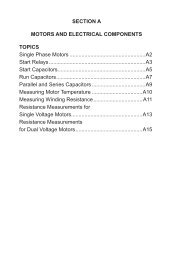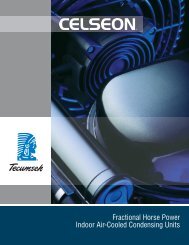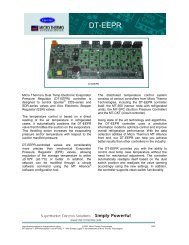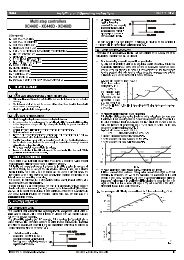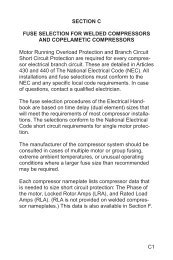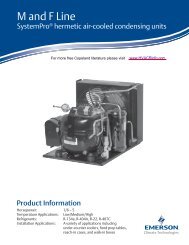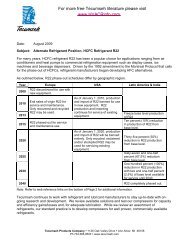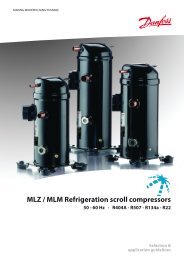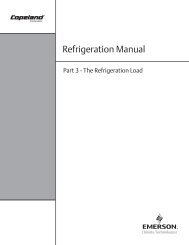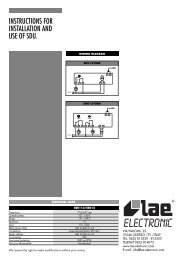indicates the dry bulb or ambient temperature, while if awick wetted with water is placed around the mercury bulb<strong>and</strong> the thermometer is exposed to rapid air movement,the temperature indicated by the thermometer will be thewet bulb temperature. The difference between the drybulb <strong>and</strong> wet bulb readings is determined by the rate ofevaporation from the wet surface of the wick, <strong>and</strong> thisin turn is proportional to the moisture content or vaporpressure of the air. The wet bulb temperature is alwayslower than the dry bulb temperature, <strong>and</strong> for a given drybulb, the less the moisture content of the air, the lowerthe wet bulb temperature will be.Since the cooling is accomplished by evaporation of thewater, water consumption is only a fraction of that usedin conventional water cooled applications in which thewater once used is discharged to a drain. Evaporativecondensing is therefore widely used in hot, arid regionsof the world.Corrosion, scale formation, <strong>and</strong> the danger of freezingare problems that must be solved with both evaporative<strong>and</strong> water cooled condensers. With both cooling towers<strong>and</strong> evaporative condensers, a bleed to a drain must beprovided to prevent the concentration of contaminantsin the cooling water.CONDENSER CAPACITYThe heat transfer capacity of a condenser dependsupon several factors:1. Surface area of the condenser .2. Temperature difference between the cooling medium<strong>and</strong> the refrigerant gas.3. Velocity of the refrigerant gas in the condenser tubes.Within the normal commercial operating range, thegreater the velocity, the better the heat transfer factor,<strong>and</strong> the greater the capacity.4. Rate of flow of the cooling medium over or throughthe condenser. Heat transfer increases with velocityfor both air <strong>and</strong> water, <strong>and</strong> in the case of air, it alsoincreases with density.5. Material of which the condenser is made. Since heattransfer differs with different materials, more efficientmetals will increase the capacity.6. Cleanliness of the heat transfer surface. Dirt, scale,or corrosion can reduce the heat transfer rate.For a given condenser, the physical characteristicsare fixed, <strong>and</strong> the primary variable is the temperaturedifference between the refrigerant gas <strong>and</strong> thecondensing medium.CONDENSING TEMPERATUREThe condensing temperature is the temperature at whichthe refrigerant gas is condensing from a vapor to a liquid.This should not be confused with the temperature ofthe cooling medium, since the condensing temperaturemust always be higher in order for heat transfer to takeplace.In order to condense the refrigerant vapor flowing intothe condenser, heat must flow from the condenser at thesame rate at which heat is introduced by the refrigerantgas entering the condenser. As mentioned previously,the only way in which the capacity of the condensercan be increased under a given set of conditions is byan increase in the temperature difference through thecondenser walls.Since a reciprocating compressor is a positivedisplacement machine, the pressure in the condenserwill continue to increase until such time as thetemperature difference between the cooling medium <strong>and</strong>the refrigerant condensing temperature is sufficientlygreat to transfer the necessary amount of heat. Witha large condenser, this temperature difference may bevery small. With a small condenser or in the event airor water flow to the condenser has been blocked, thenecessary temperature difference may be very large.This can result in dangerously high pressures, <strong>and</strong> it isessential that the condenser is operating properly anytime a refrigeration unit is in operation.The condensing temperature <strong>and</strong> therefore thecondensing pressure is determined by the capacityof the condenser, the temperature of the coolingmedium, <strong>and</strong> the heat content of the refrigerant gasbeing discharged from the compressor, which in turn isdetermined by the volume, density <strong>and</strong> temperature ofthe gas discharged.NON-CONDENSABLE GASESAir is primarily composed of nitrogen <strong>and</strong> oxygen, <strong>and</strong>both elements remain in gaseous form at all temperatures<strong>and</strong> pressures encountered in commercial refrigeration<strong>and</strong> air conditioning systems. Therefore, although thesegases can be liquefied under extremely high pressures<strong>and</strong> extremely low temperatures, they may be consideredas non-condensable in a refrigeration system.Scientists have discovered that one of the basic laws ofnature is the fact that in a combination of gases, eachgas exerts its own pressure independently of others,© 1967 Emerson Climate Technologies, Inc.All rights reserved.5-5
<strong>and</strong> the total pressure existing in a system is the totalof all the gaseous pressures present. A second basiccharacteristic of a gas is that if the space in which it isenclosed remains constant, so that it cannot exp<strong>and</strong>,its pressure will vary directly with the temperature.Therefore, if air is sealed in a system with refrigerant,the nitrogen <strong>and</strong> oxygen will each add their pressureto the system pressure, <strong>and</strong> this will increase as thetemperature rises.Since the air is non-condensable, it will usually trapin the top of the condenser <strong>and</strong> the receiver. Duringoperation the compressor discharge pressure will be acombination of the refrigerant condensing pressure plusthe pressure exerted by the nitrogen <strong>and</strong> oxygen. Theamount of pressure above normal condensing pressurethat may result will depend on the amount of trapped air,but it can easily reach 40 to 50 psig or more. Any time asystem is running with abnormally high head pressure,air in the system is a prime suspect .CONDENSING TEMPERATURE DIFFERENCEA condenser is normally selected for a system by sizing itto h<strong>and</strong>le the compressor load at a desired temperaturedifference between the condensing temperature <strong>and</strong>the expected temperature of the cooling medium.Most air cooled condensers are selected to operate ontemperature differences (commonly called TD) of 20°F. to 30° F. at design conditions, but higher <strong>and</strong> lowerTDs are sometimes used on specialized applications.St<strong>and</strong>ard production air cooled condensing units areoften designed with one condenser for a wide rangeof applications. In order to cover as wide a range aspossible, the TD at high suction pressures may be from30° F. to 40° F., while at low evaporating temperaturesthe TD often is no more than 4° F. to 10° F. The designcondensing temperature on water cooled units is normallydetermined by the temperature of the water supply <strong>and</strong>the water flow rate available, <strong>and</strong> may vary from 90° F.to 120° F.Since the condenser capacity must be greater than theevaporator capacity by the heat of compression <strong>and</strong> themotor efficiency loss, the condenser manufacturer mayrate condensers in terms of evaporator capacity, or mayrecommend a factor to allow for the heat of compressionin selecting the proper condenser size.5-6© 1967 Emerson Climate Technologies, Inc.All rights reserved.



